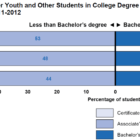
Thousands more prisoners across the US will get free college paid for by the government
|
The graduates lined up, brushing off their gowns and adjusting classmates' tassels and stoles. As the graduation march played, the 85 men appeared to hoots and cheers from their families. They marched to the stage – one surrounded by barbed wire fence and constructed by fellow prisoners








